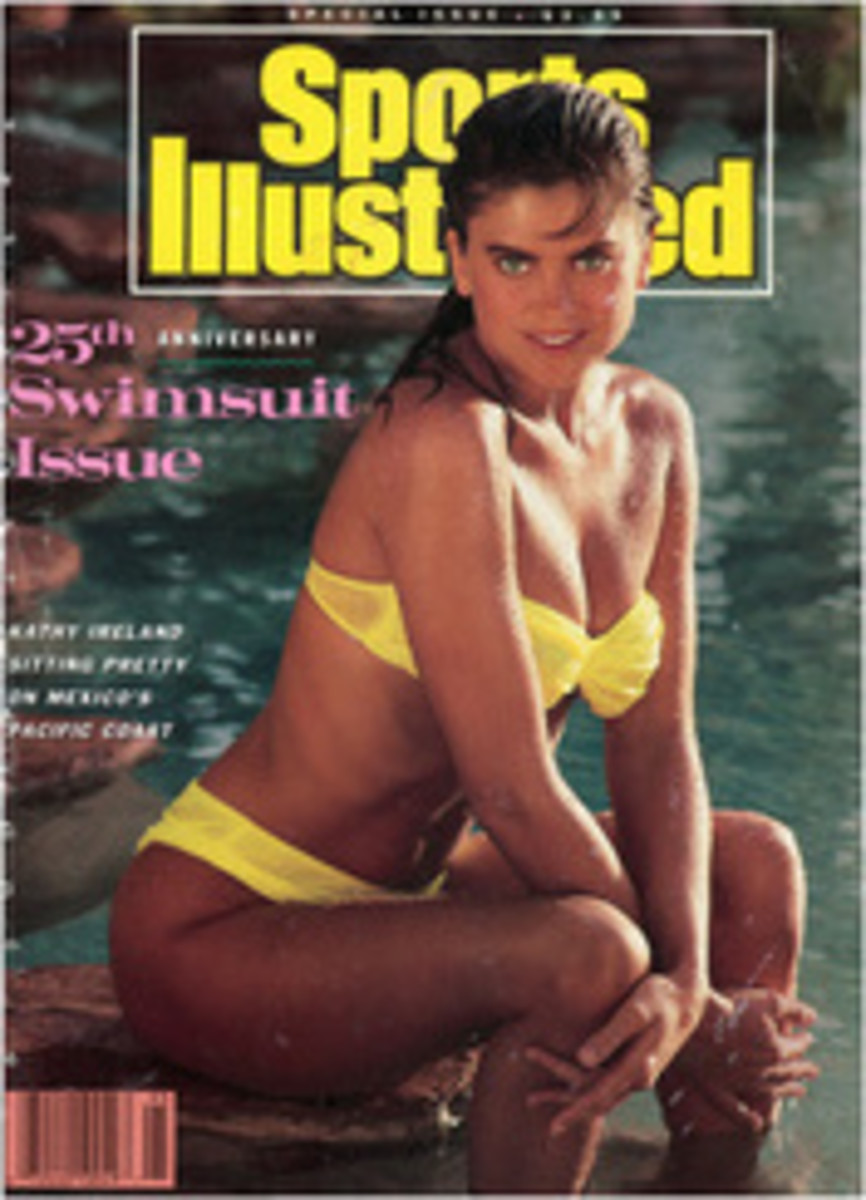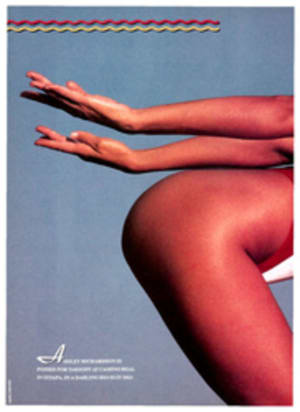
The Woman Warrior
Long, thick, red hair was her trademark. "Hi, I'm Ann Simonton, and I'm with the Ford Agency," she would bubble when being interviewed for TV commercials. She gladly obliged the creative guys from the ad agencies. Smile. Face the camera and flip around your gooorrrrrgeous hair! "Beautiful," they would say, and they would sign her to pitch products like Adorn hair spray, Vidal Sassoon shampoo or Clairol's Frost & Tip.
Simonton's freckles weren't so marketable. She was repeatedly asked to get rid of them. "Sure," she would chirp, and then she would apply covering makeup.
Simonton vaulted to the top of the modeling world in the early 1970s. In her first year out of Charter Oak High School in Covina, Calif., she earned $30,000. Her homecoming-queen looks appeared in Glamour, Mademoiselle, Seventeen, Cosmopolitan and Bride's magazines. At 22 she was SI's 1974 swimsuit-issue cover model. She had assignments in Europe and the Caribbean. She partied with the in crowd and lived on the 21st floor of a New York City high rise. A big-shot producer tried to lure her to Hollywood to make movies.
She also had to endure some uncomfortable situations. At the filming of a one-minute Camay commercial, Si-monton had to sit in a bathtub for 12 hours while prop men dumped buckets of sudsy water over her. For a lingerie commercial, the ad people scrutinized her buttocks. "There I was, bent over and dressed in a girdle, with a grown man and woman studying my derriere, saying, 'What do you think?'...'I'm not sure, what do you think?' " Simonton says. "All the while, I was thinking, What am I doing here, and why do I keep coming back for more?"
Try fame, fortune and acceptance. Simonton looked at modeling as a game, and she believed that despite the drawbacks of her profession, she was in complete control of her body. While other models wore fancy designer duds to work and caked their faces with makeup, Simonton arrived in bib overalls and sneakers, with only a hint of lipstick. While other models dieted, the 5'8", 117-pound Simonton did it her way, scarfing down bread smothered with butter and honey, or gorging on greasy falafel from street vendors.
"Diet is an important part of a model's life," Simonton says now. "Food is all they talk about. I'd show up at a job after breakfast and hear models say how guilty they felt because they had eaten a whole doughnut or an avocado. When the other girls ordered salads, I'd ask for the same but with a scoop of tuna on top and rolls to go with it."
Then, one summer day in 1979, modeling suddenly became an unacceptable way for Simonton to make a living. Thumbing through the San Francisco Examiner & Chronicle, Simonton noticed a department store ad for bed linens in which she was peering seductively from beneath a comforter. Her eyes glanced to the date at the top of the page. It was June 24, eight years to the day since she'd been gang-raped at knifepoint in a New York park on the way to a modeling assignment. Dismayed by the message of the photograph, Simonton's eyes burned with tears. "The connection between what I was doing and my rape hit me full force," she says. The following evening, she had her long red hair cut short. After 11 years, her modeling career was over.
"People still can't understand why I wasn't fulfilled as a model," Simonton says. "The most difficult part of modeling is putting up with the attitude that you're sought after only for your looks—not your brain or what's inside. It's a glamorized form of prostitution."
These days Simonton, 36, is a radical feminist who wouldn't dream of posing in a swimsuit for this issue of SI. She's a writer, a lecturer and the founder of Media Watch, a nonprofit organization based in Santa Cruz, Calif., that scrutinizes the images of women as projected on TV and radio and in newspapers, magazines, movies and rock 'n' roll lyrics.
"The main goal of Media Watch is to help people become more critical viewers of the media," she says. "I want to change the fundamental attitudes we have toward women, including women in sports. As a society, we're obsessed with male-dominated sports. We devote too much airtime and too many printed words to football. If long-distance swimming was covered as much as football, then our whole concept of sports might change, because we'd see women outdoing men left and right."
Simonton crisscrosses the U.S. presenting a thought-provoking slide show titled Sex, Power and the Media. Her aim, she says, is to destroy "the myth of the American Dream Girl." On average, she speaks four times a month and makes about $8,000 a year.
The presentation begins with a revealing analysis of her life and then addresses demeaning images of women found in advertisements and articles in men's and women's magazines. One of her slides is of an ad that claims a bra gives a career woman much-needed freedom; another shows a ditzy gal who takes control of her life by using the right hair conditioner. This is followed by clothing ads that Simonton believes make light of inhuman treatment of women—a model tied up with belts. a teenager with a hot iron on her stomach. Two hours and some 200 slides later, Simonton reaches a fever pitch with obscene photos of raped and dismembered women. She closes with a plea, asking SPORTS ILLUSTRATED to discontinue the swimsuit issue and replace it with a magazine devoted solely to women athletes.
"The swimsuit issue encourages violence and hatred toward women," Simonton says. "It dehumanizes women, turns them into objects. The ratings start the minute the issue is opened: 'I like her because of her breasts.'...'Look at the gams on this babe.' "
Simonton is equally outspoken in criticizing other examples of what she believes are destructive images of women. Here are a few samples:
•Jane Fonda: "Fonda is obsessed with youth and her own physicality. How good she looks will determine her future. That doesn't increase the dignity of women at all."
•Dynasty: "The TV show with the greatest misconceptions about women's conditions. Dynasty women eat chocolates, wear gorgeous clothes, sit around the house and pick up any man they want in a bar."
•The NFL cheerleader: "She's a symbol for the role that women are asked to play in all aspects of men's lives. Women are asked to be men's cheerleaders, to pump them up and soothe them on their bad days, to cheer them off to work and be sexually available when they return."
•Florence Griffith Joyner: "A woman athlete shouldn't feel she has to dress in a way that proves her sexuality."
Though it may be hard to believe, Simonton's actions actually are tougher than her words. An advocate of civil disobedience, she has been arrested 11 times for such acts as littering (one of the roses in a bouquet she was carrying fell to the sidewalk during a protest; she sued and got a $10,000 out-of-court settlement), tearing up a copy of Hustler magazine (she hadn't paid for it), taking her shirt off at a state beach ("I was challenging a sexually discriminative law"), and pouring a few drops of her blood on a sidewalk as a protest against rape. "I'm not going to stand on a soapbox and hand out leaflets," she says. "I want to make sure a lot of people hear about the issues."
For the past nine years, she and other feminists have protested against the Miss California pageant by staging a Myth California contest, an elaborate bit of street theater. To demonstrate her feeling that beauty pageants treat women as "pieces of meat," Simonton has worn an evening gown made from 30 pounds of bologna and a necklace of miniature wieners. "Bologna is very greasy, and it really smells," she says, laughing. "It was all I could do to fight off stray dogs."
That battle was easy compared with the one she must fight while trying to get across her feminist messages. The enormity of the task is reflected in the mounds of clutter in her garage, which also happens to be the Media Watch office. The walls are plastered with memorabilia: photographs of Simonton and her four sisters as prim and proper little girls in Harlan, Ky.; a swatch of handmade black lace belonging to her maternal grandmother, Mary Dudley Pittman, the first woman registrar of Raleigh, N.C.; crayon drawings by her six-year-old nephew, Charlie Simonton-Bernatowicz.
"I live among monied women, who are into their houses, cars, nails and outfits," says Simonton's longtime friend Susan Nash, the wife of rock singer Graham Nash. "But they don't have it all, because they forgot to work on their heart and compassion. Annie's heart is wide and encompassing. Her passion is not self-serving. She's 'out there.' But get real. Who wants to hear her message? I don't think she'll ever be accepted."
Adds older sister Meg Simonton: "Undergoing this radical change in her life was psychological torture. Ann grew up wanting everybody to like her. A lot of people think she's a totally ridiculous spectacle. But she doesn't care anymore if they like her, only that they remember her message."
To bolster her fighting spirit, Simonton has competed in rough-water swims off the Santa Cruz wharf, climbed a 200-foot redwood tree with her live-in companion, Joseph Schultz, and gone rock climbing in the Grand Tetons. To clear her mind and get in touch with her heart, she studies African dance and goes on solitary hikes just outside Death Valley.
"I feel blessed to have found my niche in life," Simonton says. "Very few people have a job that's tailor-made for them. This is a new frontier, with thousands of directions. I'm truly happy and fulfilled."
THREE ILLUSTRATIONS
PHOTO
JAY MAISEL
PHOTO
GREGORY HEISLER
SIMONTON HAS SACRIFICED MUCH FOR THE CAUSE—SHE IS NOW LIVING ON $8,000 A YEAR
PHOTO
GREGORY HEISLER
TO SPREAD HER MESSAGE, SIMONTON OFTEN GIVES TWO-HOUR PRESENTATIONS
PHOTO
UPI/BSTTMANN NEWSPHOTO
PROTEST '87: NO HAIR AND A BOLOGNA DRESS

